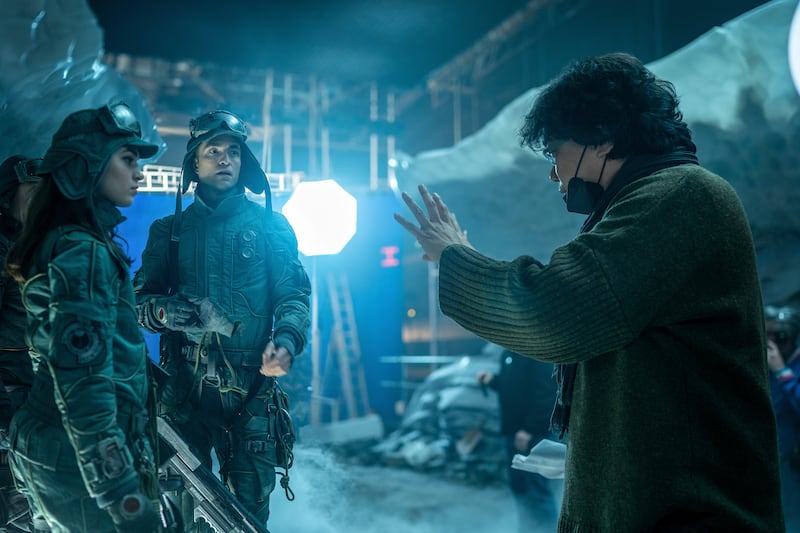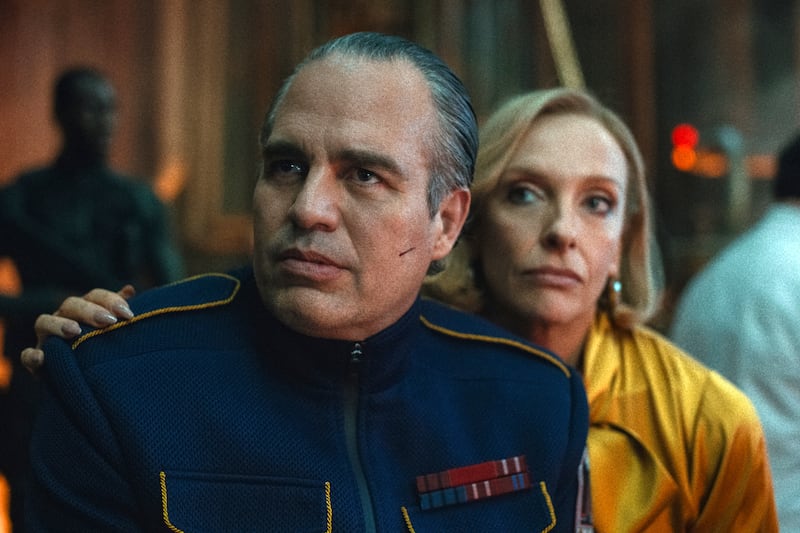“Prove to me your faith in the system.”
This is one of the phrases uttered early into Academy Award-winning director Bong Joon-ho’s first film since his Oscar win for “Parasite” in 2020. With a simple demand, he asks the viewer, “as a mere cog, would you be willing to sacrifice yourself for the machine?”
The film features a bloated ex-congressman (Mark Ruffalo) who is wholly incapable without affirmation from his wife. He waxes poetic about colonizing a planet with a “pure” human race while inauthentically spouting religious platitudes for the sake of political gain. “The church” has been rebranded “the company.” All the while, red-hatted supporters plead for salvation to a politician who could only classify the world as “me and everyone else.”
That’s all to say that Bong is not exactly the most subtle filmmaker.
“Mickey 17″ is the South Korean director’s latest venture into his exploration of class conflict, authoritarian rule and capitalist dystopia. It is a brand that suits him well after “Parasite,” a movie examining the lives of an impoverished family and a wealthy family, netted him international acclaim.
However, Bong likes to oscillate, jumping between fantastical and grounded, between English and Korean. “Mickey 17″ features Robert Pattinson as the titular character, and also as Mickey’s 1 through 16, alongside 18 as well. He serves the role as an “Expendable,” a worker who signs up to be killed and reprinted again over and over to complete everything from menial tasks to suicide missions on an unknown planet.

When Mickey joins an intergalactic colonizing expedition headed by Ruffalo’s Kenneth Marshall, he ends up falling in love with security agent Nasha Barridge (Naomi Ackie). While all seems to go well, a logistical error results in the coexistence of multiples: two Mickeys simultaneously.
Based on the book “Mickey7″ by Edward Ashton, the movie’s rights were already obtained by Warner Brothers even before the source material was officially published in North America. While there were numerous delays, the movie is well worth the wait.
Much like the rest of Bong’s filmography, he is endlessly fascinated by the relationship between the ordinary man and those in power. Mickey Barnes is the definition of the everyman—Pattinson accidentally emulates Steve Buscemi as a debtor trying to escape a bloodthirsty loan shark only to end up on a ship headed towards the frozen planet of Niflheim in a constant cycle of death.
In the meantime, Marshall and his wife Ylfa (Toni Collette) imposes strict requirements on the ship: limits on rations, no sexual intercourse (for the sake of conserving calories) and most of all, no multiples. The ship’s interior serves as an experiment in government, not too unlike the trains seen in Bong’s “Snowpiercer.” The wealthy and powerful can live on the glory built by the ordinary while those on the ground face death each day, often oblivious to their exploitation.
According to Bong, Marshall is a stand-in for the “bad” political leaders of the world onto which audiences can project their country’s own tumultuous political situation.
Like every well-oiled capitalist machine, there are cracks underneath the surface. Even within a spaceship, there are underhanded drug deals, the threat of cutting resources if one fails to do their job and constant experimentation on the Expendable because at a certain point they are viewed as less than human.
While the premise sounds bleak, Bong manages to create a captivating and hilarious cinematic experience, in part because of his sharp direction, as well as due to the nature of the performances.

Pattinson has become something of a Hollywood curiosity in recent years. Once known as the heartthrob from the “Twilight” series and the iconic victim in “Harry Potter,” he has since transformed himself into a caped crusader and scheming heron, working with directors like Christopher Nolan, Robert Eggers, and the Safdie brothers.
At the hands of Bong, however, Pattinson takes on the challenge of being a bit of a bumbling fool. He is blissfully unaware of the external world and fixates himself on the love of his life. That is until one day, due to accidental survival and a mix up in schedule, Mickey 17 comes face to face with Mickey 18. With each clone having a slightly different personality, Mickey 18 is far more jaded and vengeful compared to the stuttering 17.
The contrasting roles fit well onto the ship’s bizarre cast of characters and serve as a canvas for Bong’s thematic curiosity. One is ready to kill for his freedom while the other, once willing to die over and over again for the political system, slowly realizes his desire to live.
This interest in showcasing societal inequality and the plight of the ordinary can date back to even Bong’s earliest works. His 1994 student short film “Incoherence” is the logline for his career, showing three middle-aged men engaging in comically risky behavior. The twist—they are all men of influence or expertise hypocritically commenting on the decay of society as if they are not entirely complicit in the actions they criticize others of.
“Memories of Murder” sees detectives abusing their power for the sake of closing a case and saving face. “Mother” discusses a widow willing to embrace darkness for the sake of protecting her intellectually disabled son.

Circumstance as cause seems to be a throughline in many of Bong’s works, but another recurring theme he decides to tackle in “Mickey 17″ is man’s relationship with nature.
He is no stranger to monster movies, having directed “The Host” and even “Okja,” which featured a large hippo-like creature. “Mickey 17″ introduces the creepers, a race of tardigrade-like animals that inhabit Niflheim prior to the arrival of Marshall’s expedition.
The most surprising aspect of the film is how central these creatures are to the story’s driving narrative. Taking cues from films like “Nausicaä and the Valley of the Wind,” the movie paints them as peaceful creatures willing to threaten and defend if the otherworldly invaders hurt their own.
The “man vs. nature” scenario overtakes the back half of the movie while acting as a mirror to how humanity often acts. Whatever they do not understand must be hostile. If it is in the way of their mission to conquer, it must be violent.
What sets it apart from every other film sympathizing with nature under threat, is that Bong imposes the same level of snarky and comedic writing onto them as well.
The mix of heavily improved visual effects since Bong’s last creature feature alongside stunning cinematography Darius Khondji (“Seven,” “Uncut Gems,” “Okja”) add to this unique cinematic landscape. Production designer Fiona Crombie (“The Favourite,” “Beau is Afraid”) works to make this science fiction world feel as distinct as possible from its peers—whether it be the cloning machine that resembles an X-ray scanner or a two-bladed chainsaw used to bisect debtors.

By its end, “Mickey 17″ ends up far more existential than most of Bong’s other works. It questions the nature of the soul and defines humanity as distinct rather than faceless disposability. To that end, it may be one of Bong’s more accessible works as a charming crowd-pleaser with a biting narrative and compelling performances.
It is a movie that advocates for a world of community,one that respects the existence of each person and even the nature that surrounds them. Blind faith in a system will leave a person believing they are expendable, but realizing one’s individuality—that is when the value of life is truly recognized.
